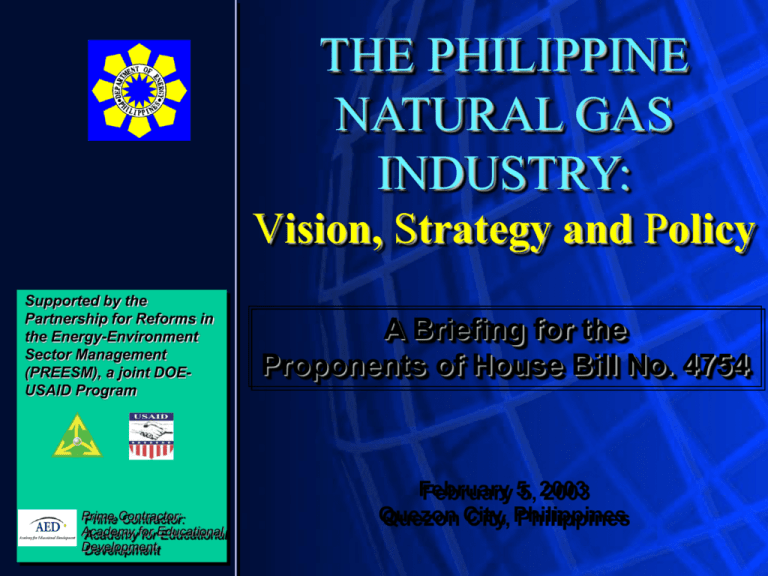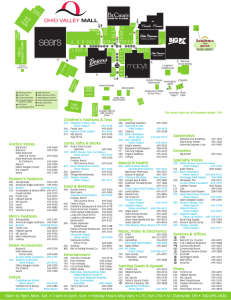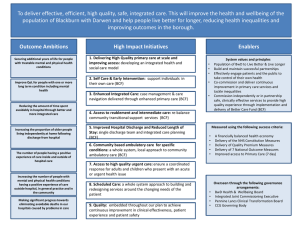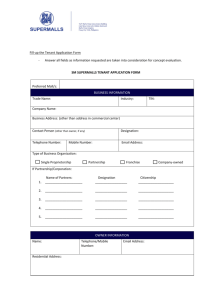Philippines Grid & Distribution Code
advertisement

THE PHILIPPINE NATURAL GAS INDUSTRY: Vision, Strategy and Policy Supported by the Partnership for Reforms in the Energy-Environment Sector Management (PREESM), a joint DOEUSAID Program Prime Contractor: Academy for Educational Development A Briefing for the Proponents of House Bill No. 4754 February 5, 2003 Quezon City, Philippines Briefing Outline Importance of Nat Gas Industry Industry Status Regulatory Concepts Proposed Framework Potential issues on HB 4754 Why Should We Care? Security of Supply Energy Self Sufficiency Eco Social Benefits Foreign Exchange Savings of $ 4.5 B STATUS Birth of the Gas Industry Upstream Sector San Antonio Gas Field, 2.7 BCF Malampaya Gas Field, 3.7 TCF Birth of the Gas Industry Malampaya Gas-to-Power Project 30 km 504 km Ups tre am Gas dehydration Gas dewpointing Condens ate s tabilisation Export compres sion Catenary Anchored Leg Mooring (CALM) buoy for tanker loading of condensate Do wns tre am Sulphur Recovery H2S removal Metering Supply bas e Batangas - 0m Power Stations Alternative Fuel M a n il a - 43 m 3rd flowline (2021) Subs ea manifold - 820 m Condens ate storage Condensate export 24" Dry gas pipeline S an L o re n z o S a n ta R it a Il i ja n (N P C ) 2 x 16” CRA wet gas Malam p aya P LAT FORM Development wells 9 9Development wells 1 Contingency well T a b a n g a o R e fi n e ry B a ta n g a s Birth of the Gas Industry Downstream Sector Gas Pipelines and 2700-MW Gas Fired Power Plants San Lorenzo Power Plant First Gas Corp, 560 MW Operating October 2002 Sta. Rita Power Plant First Gas Corp. 1,000 MW Operating Jan 2002 Onshore Gas Plant SC 38 Consortium Operating Tabangao 504 km. 24-inch Pipeline SC 38 Consortium Ilijan Power Plant KEILCO, 1200 MW Operating June 2002 Oct 2001 Birth of the Gas Industry Downstream Sector PNOC CNG-Refilling Station and NGVs Natural Gas Production and Consumption of Asian Countries* 3000 Billion cubic feet 2500 2000 1500 1000 500 Ja pa n M al ay si a Pa ki st Ph an ili pp in es Si ng ap So or e ut h K or ea Ta iw an Th ai la nd si a do ne In na Ch i ei Br un di a In Ba n gl ad e sh 0 Production Bcf *Phil- 2002 data; all other countries- 2000 Consumption Bcf Source of Data: BP Amoco Statistical Review Development and Growth Development and Growth Policies and Objectives Policies Promote natural gas as an environment-friendly, secure, stable and economically efficient source of energy Promote competition by liberalizing entry into the industry and adopting pro-competitive and fair trade measures Ensure compliance with Philippine environmental laws and regulations and international safety standards Objectives Competitive natural gas prices vis-à-vis other fuels Increased utilization of natural gas as fuel in power and non-power sectors Increased share of natural gas in the energy mix Adoption of state-of-theart technology, development of experts and increased employment Enhanced economic benefits to consumers Development and Growth Natural Gas Share in Energy Mix (In %) 2001 2007 2012 GDP growth p.a. 3.2 5.2 5.2 Oil 45.3 38.6 39.6 Coal 9.2 9.7 5.3 Indigenous 45.5 51 44.4 Gas 0.6 7.0 6.0 Other RE 31 27.9 24 Local Coal 1.5 1.9 4 Hydro 4.9 4.1 3.1 Geothermal 7.2 7.7 5.8 Local Oil 0.1 2.4 1.4 0.7 10.7 Others (unidentified) Development and Growth Gas Resources Total Resources: 28,531 BCF (Mean) Undiscovered 24,690 BCF Discovered Undiscovered Discovered 3,841 BCF Development and Growth Location of Petroleum Resources Found in 16 sedimentary basins with an area of over 700,000 sq. km. Ilocos Cagayan Central West Luzon Luzon Southeast Bicol Luzon Shelf Mindoro - Cuyo Northwest Palawan Southwest Palawan East Palawan Reed Bank West Masbate / Iloilo Visayan Cotabato Agusan Sulu - Davao Sea Projected Demand and Possible Importation of Natural Gas 400 350 300 250 BCF 200 Possible importation 150 Projected demand 100 50 Year 20 12 20 11 20 10 20 09 20 08 20 07 20 06 20 05 20 04 20 03 0 Development and Growth Proposed Gas Pipeline Infrastructure BatMan 2 ? ? BatCave BatMan 1 Malampaya Assumed Pipeline Route Development and Growth Potential Gas-Fired Power Plants Limay 620 MW (2008) Conversion Additional Greenfield Capacity Requirement in Luzon Sucat 300 MW (2008) 600 MW (2009) Malaya 600 MW (2010) Conversion 300 MW (2010) 1,200 MW (2011) 600 MW (2012) Santa Rita 1000 MW (2002) San Lorenzo 560 MW (2002) Ilijan 1200 MW (2002) Development and Growth Potential Commercial Gas Markets 1 Gotesco Mall 2 Commonwealth Center 3 SM North Edsa 4 Araneta Center 5 Greenhills Mall 2 1 8 EDSA Central 9 4 5 11 10 12 15 9 Tutuban Mall 10 Robinson’s Place 11 SM Manila 12 Harrison Plaza 13 18 SM Southmall 19 Alabang Town Center 3 6 SM Megamall 7 Shangri-la Plaza 17 Fiesta Mall (Duty Free) N EDSA Monumento 20 Festival Mall / Metropolis 6 7 8 14 Fort 16 Bonifacio 17 18 13 Coastal Mall 14 Rockwell 15 Greenbelt Mall 20 19 16 Ayala Center Existing Shopping Malls Source: FS on CNG Development for Public Utility Vehicles in Metro Manila Development and Growth Proposed CNG Infrastructure EDSA Monumento Refilling Station in 2005 Refilling Station in 2003 Manila Gas Corp. Pipeline Fort Bonifacio Proposed EDSA Gas Pipeline Large Refilling Stations2 Proposed Sucat to Fort Bonifacio Gas Pipeline Metro Manila Bus Routes Batman 1 Stations (L): 1 EDSA Monumento 2 Fort Bonifacio GAS INDUSTRY REGULATION • • • • Basic Concepts Industry Structure Stages of Gas Market Development International Experience Natural Gas Industry Fundamentals What is natural gas? Source: Australian Gas Association Natural Gas Industry Fundamentals Natural gas was formed from the remains of plants and animals which lived on the Earth many millions of years ago. Over time the remains were covered by layers of sand, rock and ice. Heat and pressure eventually changed them into fossils. The gaseous form of these fossils is natural gas Source: Australian Gas Association Natural Gas Industry Fundamentals To reach natural gas we have to drill through layers of rock. Sandstone Shale Natural gas Oil Granite Coal, oil and gas are hydrocarbons (compounds made up mostly of hydrogen and carbon). Source: Australian Gas Association Natural Gas Industry Fundamentals How does natural gas get to town? 1 1 drilling rig 2 extraction unit to clean gas Transmission pipelines 3 Transmission pipelines 2 3 compressor station to maintain pressure in the pipeline 4 facility where an odour (or smell) is added 5 town - factories, houses, hospitals and hotels etc 5 4 Distribution and reticulation pipelines Source: Australian Gas Association How is natural gas used? Household use cooling manufacturing water heating power generation cooking fuel for cars heating Source: Australian Gas Association fuel for buses and trucks Natural Gas Industry Fundamentals Why is natural gas better for the environment? Natural gas is a clean and efficient fuel. Natural gas can help reduce emissions that contribute to the greenhouse effect, because it burns more cleanly than other fossil fuels. For example, when used to make electricity, natural gas only produces around half the greenhouse emissions of other fossil fuels. Source: Australian Gas Association The Natural Gas Industry Chain Upstream Production Downstream Transmission Distribution Wholesale contracts Wholesale contracts Wholesale contracts Aggregators/ Suppliers Industrial and power generation customers Retail tariffs Residential and commercial customers The gas transport chain The gas marketing chain Source: Australian Gas Association Rationale for Gas Industry Regulation Gas industry characteristics Natural monopoly Large sunk costs Public good Role of Regulation Prevent abuse of market power Minimize risks Protect public interest Objective Competition and Efficiency Encourage investments Security and affordability of gas supply Concepts and International Experience Key Elements of Gas Regulatory Regime What to regulate How to regulate Who to regulate Structure Approaches Institution/ Authority • Ownership- State/Private sector role • Vertical integration/cross-ownership • Stage of Gas Market Development • • • • • Entry Regulation Price Regulation Access Regime Public Service Obligations Promotion of Competition • Law- and Policy/Rule-making • Economic Regulator • Competition Authorities • Arbitration/Dispute Resolution Stages of Gas Market Development Market Creation Market Development Mature Market Undeveloped gas reserves, small market Limited infrastructure More supply options; rapid demand growth Heavy investments in infrastructure Abundant supplies and demand saturation Developed infrastructure Integrated Structure; monopolymonopsony operations Producers sell some gas directly to buyers; third party access and large market competition Unbundled supply chain; gas spot market; Retail competition Heavy regulation or state participation Regulation manages Minimal government competition; assists intervention to entry of new players sustain competition Stages of Gas Market Development Stage: Gas Market Creation Structure: Vertically Integrated Monopoly PRODUCERS/ TRANSMISSION DISTRIBUTION IMPORTERS COMPANY COMPANY Gas Transportation Gas Supply Transaction END USERS Stages of Gas Market Development Stage: Gas Market Development Structure: Open Access And Wholesale Competition PRODUCERS/ IMPORTERS DISTRIBUTION COMPANY TRANSMISSION COMPANY Residential Commercial Industrial TRADERS AND SUPPLIERS Gas Transportation Gas Supply Transaction Power Plants Stages of Gas Market Development Stage: Mature Market Structure: Unbundled Industry and Retail Competition Residential PRODUCERS/ IMPORTERS TRANSMISSION COMPANY DISTRIBUTION COMPANY Commercial Industrial SPOT MARKET Gas Transportation Gas Supply Transaction TRADERS AND SUPPLIERS Power Plants Gas Market Development in Selected Countries Market Creation IND 3 72 ARG US UK 30 26 167 27 R/P Ratio (Years)1 32 19 52 24 20 9 % NGas in 4.6 28 30 47 25 55 26 Energy (2002) Mix* Pipeline 526 4,469 377 1,753 12,000 >100,000 1.84 (1998) MM Km* 7 38 1 THAI MAL Mature Market MEX Proven Reserves (TCF)* PHIL Market Development 12 Ratio of year-end reserves to annual production Source of basic data: WB, BP Amoco, APERC * 2000 data 82 278,650 Evolution of Regulatory Reforms in Mature Gas Markets – United States Partial wellhead price deregulation 500 Total wellhead price decontrol 400 Voluntary open access 300 200 100 Heavy Regulation Mandatory open access, Unbundling, Capacity release, wholesale price decontrol Managed Competition Retail competition in some states Deregulation 0 19 70 19 72 19 74 19 76 19 78 19 80 19 82 19 84 19 86 19 88 19 90 19 92 19 94 19 96 19 98 In million tons of oil equivalent 600 Production Prodn + Imports Consumption Source: F. M. Andres, unpublished thesis Evolution of Regulatory Reforms in Mature Gas Markets - United Kingdom 90 70 TPA to BG pipelines 60 BG privatization, large market competition 50 40 Retail market competition BG creation 30 BG unbundling 20 10 Nationalization Managed Competition Competition 0 19 70 19 72 19 74 19 76 19 78 19 80 19 82 19 84 19 86 19 88 19 90 19 92 19 94 19 96 19 98 In million tons of oil equivalent 80 Consumption Prodn + Imports Production Source: F. M. Andres, unpublished thesis Evolution of Regulatory Reforms in Mature Markets - Argentina 35 25 20 Capacity release market 15 YPF divestment 10 Compe tition 5 Managed Competition Nationalization Production Prodn + Imports 19 97 19 95 19 93 19 91 19 89 19 87 19 85 19 83 19 81 19 79 19 77 19 75 19 73 0 19 71 In million tons of oil equivalent Wellhead price deregulation Gas del Estado restructuring and privatization , open access, YPF privatization 30 Consumption Source: F. M. Andres, unpublished thesis Lessons Learned from International Experience US and UK experience are “experiments” – piecemeal approach to deregulation/liberalization Latter reformers (e.g., Argentina, Victoria) took a more proactive, quicker path to gas reform No single entity should have excessive market power for competition to work Regulation needs complementary measures to work – e. g., TPA and unbundling Electricity market deregulation hastens gas market competition but drives reintegration POLICY AND REGULATORY FRAMEWORK • Existing Legal and Policy Framework • DOE Gas Circular Existing Policy and Regulatory Framework Recent Developments • DOE Charter • E.O. No. 66 • DOE Gas Circular – Interim Regulations • Philippine Energy Plan 2003-2012 Rules and Interim DOE Gas Circular Policy Declaration • • • • Promote Natural Gas as an efficient and economical source of energy Facilitate private sector participation Promote competition by liberalizing entry and adopting pro-competition/fair trade measures Ensure compliance with international safety standards and relevant Philippine laws and regulations Interim DOE Gas Circular Key Provisions Industry Structure Downstream Natural Gas Industry: Transmission (T), Distribution (D) and Supply (S) Vertical integration allowed Entry Regulation Franchise and other legislative authorizations required to operate T& D as public utility Permits required for T, D and S Own-use permit allowed for end-user facilities Interim DOE Gas Circular Key Provisions Access Liberalization Third Party Access to T, D and related facilities required Deferment allowed on new facilities Access conditions negotiated Price regulation Prices of T, D, and S deregulated for competitive markets. ERC to regulate prices charged by distribution utilities Promotion of Competition DOE to enforce measures to restore competition Proposed Natural Gas Bill Natural Gas Bill TWG Meetings and Participants Meetings 11 meetings since September 2002 Participants Committee on Energy Secretariat Government – DOE, ERC, DOF, DENR, NEDA, PNOC, PNOC-EC. PNOC-EDC Industry – SPEX, FGHC, PAP, BP Amoco, GN Power, Chevron-Texaco, Caltex, Price-Waterhouse NGO – Freedom from Debt Coalition Major Issues Regulatory Agencies Franchise Price Regulation TPA Promotion of Competition Natural Gas Bill Key Recommendations of the TWG Industry structure Downstream gas industry: T, D and S Vertical integration allowed Entry regulation Franchise to operate T & D as public utility Permit required to operate T, D & S Own-use permit allowed for end-user facilities Natural Gas Bill Key Recommendations Access Liberalization TPA mandatory for T, D and related facilities Deferment allowed on new facilities Access conditions negotiated Price Regulation Prices for captive markets regulated Market-based prices for contestable markets Natural Gas Bill Issues to be resolved Regulatory Agencies Division of price and non-price functions between DOE and ERC or single regulatory agency Franchise Whether Service Contractors need a franchise to engage in T & D PNOC Charter in lieu of a franchise Price Regulation Classifying markets as contestable or captive for pricing purposes Natural Gas Bill Issues to be resolved Third Party Access Whether to require T, D utilities capacity expansion to accommodate third party users Negotiated versus regulated access charges Promotion of Competition What competition measures to be imposed Whether to identify measures in the legislation or empower regulator to determine THANK YOU! www.doe.gov.ph







